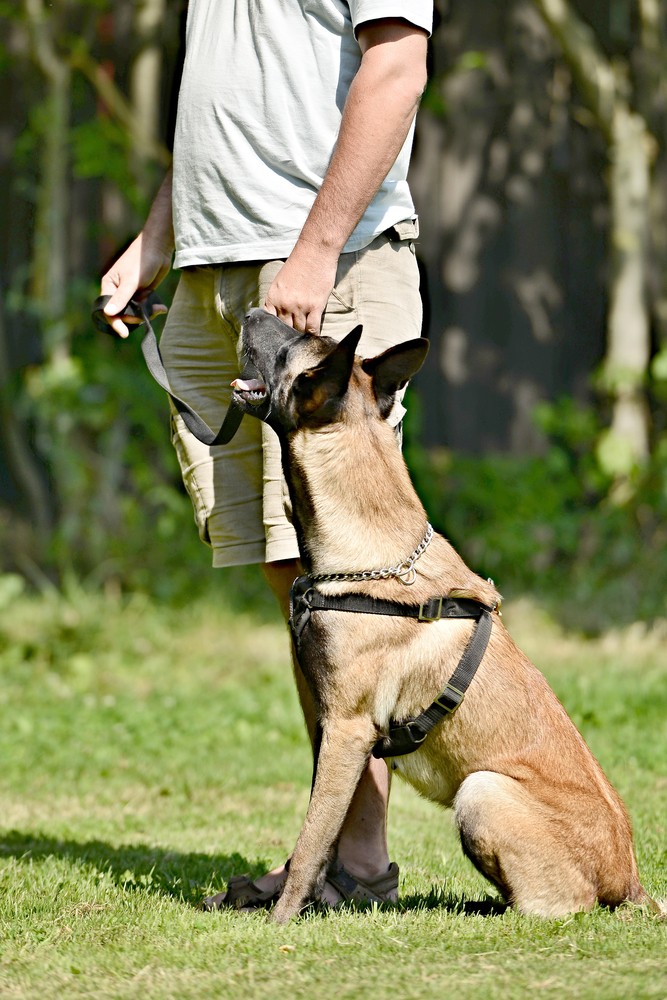Got Stay? Walking Around Your Dog
Many dogs struggle with the handler walking around the dog during a stay exercise. The key to success for stays is to break it down! Stay training consists of slowly and carefully increasing difficulty to ensure success.
When you first start stays, you want to make sure you are really splitting, meaning you are breaking down the behavior into tiny little pieces. At first I don't move my feet at all. I make sure I get some duration on the behavior before I start moving. When I do start moving I just start with weight shifts, rocking back and forth on each foot.
Then I'll take a tiny step.
I'm rewarding often at this stage. Eventually I'll start to move around more. I've already introduced the concept of distraction with the treats early on in our training, so as my dog gets comfortable with duration and a little bit of distance, I'll add some more distractions.
I'm very careful to only increase the difficulty of one D at at time - duration, distraction, or distance. When I add more of a certain challenge, I will make the others easier.
For instance, when I start introducing new distractions, I will not move far away from my dog and I'll keep the stays short. When I add more distance I will shorten the stays and make sure there aren't difficult distractions.
It's important to remember that stays must be built on success. If you are having many mistakes you need to make things easier. I have a two mistake rule. If my dog breaks position, I will try the same thing again, but if he or she makes a mistake a second time I will make the next rep super easy so the dog can be successful, then start building from there. It's very important to me that minimal mistakes are made during stay training.
Teaching A Solid Stay
Here is a video of Excel as a puppy (isn't he cute?!) working on stays. During this session, I used a sit platform to help keep Excel in place. Using a sit platform is an excellent way to start stays because it anchors the dog, plus the dog really notices when they move position because instead of just standing up, he or she actually has to get off the platform. Notice how often I'm rewarding Excel. See how I'm trying to work my way behind him, but as he struggles I make it easier for him? Going behind your dog is super hard for the dog because he or she wants to look at you. As the dog looks at you and you go behind, he or she has to get up in order to continue looking at you. I really want to take my time in breaking this skill down.
Another thing I want you to notice is how I release Excel. I go very still when I say his release word "break" then after he moves I throw a reset treat. Many people accidentally pair the release word with movement, and the dog is breaking on the movement, not the release. Be sure you are very still as you say your release word. If you need to help the dog because he or she doesn't get up on your release word, that's fine, but when you say the word don't move.
Here's another cute puppy video! This one is Strive as a pup working on stays. Here I'm doing a bit more proofing with throwing a ball, but there's a section in the middle when I am working on going behind her, so you might find that useful. Like with Excel, I reward her with her head straight forward.
In the following videos of Excel, I'm using the word "wait" instead of stay. You can choose to use whatever word you're comfortable with. During the first repetition of the stay, I accidentally dropped the treat. Because we haven't gotten to the proofing part of stays yet, I don't expect Excel to hold his position through that so he got a freebie.
Walking Behind the Dog
During this video I am able to go behind him, but if your dog isn't used to that it probably won't happen on the first session! Take your time and really get the dog comfortable with stays before you try this step.
In this video I am continuing to work on going behind Excel. Some dogs do better if you're further away from them when you go behind. Notice how I continue to reward Excel with his head forward, and I keep my rate of reinforcement high to help him be successful.
Walking Around the Dog
Here is a video of what the complete behavior should look like. Your dog heels into the sit, you tell them to stay or wait, and you walk behind the dog, pausing as you get back to heel position.
If you break this behavior down, it isn't that hard to train! Be careful not to push or test the dog, which nearly always results in a mistake. Build on success!
Want to learn more from Nicole? Check out her class Get Ready to Rally - Foundation Skills! Registration closes February 15, 2023.
By accepting you will be accessing a service provided by a third-party external to https://www.fenzidogsportsacademy.com/
